How Does a VPN Work?
A virtual private network, or VPN, secures data transfers across the internet by creating an encrypted tunnel between the user's device and a remote server.
It involves configuring a secure network, authenticating user access, establishing a protected tunnel, and maintaining and terminating connections. VPNs enable secure remote access to company resources by ensuring data remains encrypted and inaccessible to unauthorized users.
1. Pre-Connection Setup
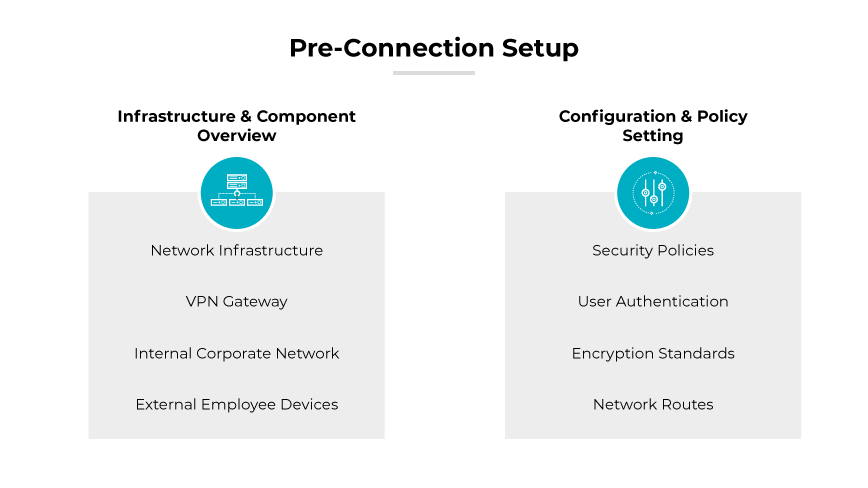
Infrastructure and Component Overview
Corporate virtual private networks (VPN) rely on the coordinated function of the VPN server or gateway, client software, and the underlying network infrastructure.
The VPN gateway sits at the network's edge. It functions as a bridge between the internal corporate network and external devices, implementing security measures for data traffic. Client software, installed on employee devices, initiates the VPN connection and handles ongoing communication with the VPN gateway. Network infrastructure includes routers, switches, and firewalls that maintain network integrity and facilitate data flow.
Configuration and Policy Setting
Before connecting to the internet through a VPN, there's a series of steps that must be followed. Initial VPN configuration requires careful setup.
Administrators define security policies and access rules to govern the flow of traffic and dictate user permissions. This involves establishing a secure communication protocol, selecting strong encryption standards, and configuring network routes that the encrypted VPN traffic will follow.
Access rules are set to specify which users can access which network resources when connected via VPN. This ensures employees have the appropriate level of network access, and company data and personal information remain secure.
2. The Initiation Phase
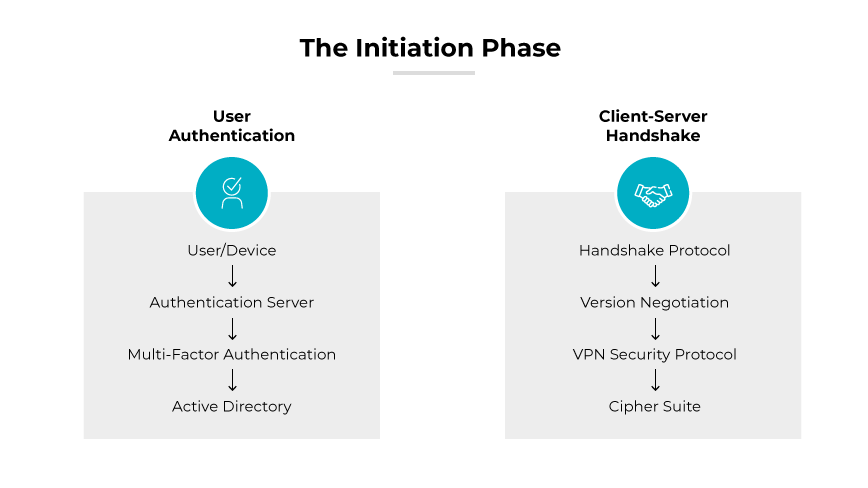
User Authentication
User authentication is the beginning of the VPN initiation phase. This process verifies the identity of the user attempting to access the network. Certificates issued by a trusted certificate authority confirm the legitimacy of the user's device.
Multifactor authentication adds an additional security layer by requiring the user to provide two or more verification factors. This could include a password, a physical token, or a biometric verification. Directory services, such as Active Directory, centralize credential management and enforce access policies, ensuring that only authenticated users gain network access.
The authentication process protects against unauthorized access from both the local network and the wider internet.
Client-Server Handshake
Following successful authentication, the client and server commence a handshake protocol. This step involves version negotiation where the client and server agree on the VPN security protocol version to be used. They also select a cipher suite, which dictates the encryption algorithm and key exchange method.
The handshake ensures both the client and server have the necessary credentials and cryptographic capabilities to establish a secure communication channel. It is the foundation for all subsequent data exchanges across the encrypted connection, from the user to the internet service provider (ISP)—and through to the VPN server.
3. Establishing the Tunnel

Protocol Selection and Security Considerations
Once the client-server handshake is complete, the focus shifts to establishing the VPN tunnel. The tunneling protocol is the core that supports secure data passage. Both the client and server agree on a tunneling protocol (such as IPsec or L2TP) that suits their security requirements and network capabilities. Tunneling protocol selection determines the level of security, compatibility with existing infrastructure, and the ability to traverse firewalls and network address translators (NATs).
Key Exchange and Encryption Mechanisms
Following protocol selection, the secure channel's creation begins with a key exchange. The Diffie-Hellman (DH) algorithm is often the choice for such exchanges. This provides a way to securely generate and share a key between the two parties without the need to transmit the key itself over the internet. In this mechanism, both client and server generate temporary key pairs—private and public—and exchange the public keys between them. Each side then combines the received public key with its own private key to generate a shared secret.
Further security is provided by employing advanced DH groups with larger key sizes. Additionally, cryptographic algorithms such as AES are used to encrypt the shared secret, providing another layer of security. Some implementations use perfect forward secrecy (PFS), ensuring that the compromise of one key will not lead to the compromise of all subsequent keys.
The secure channel is pivotal for maintaining data confidentiality and integrity in all communications between the client and the corporate network. Once established, the secure channel acts as a protective tunnel for data traffic. This ensures sensitive information sent through the tunnel remains encrypted and inaccessible to anyone without the decryption key.
4. Data Transfer
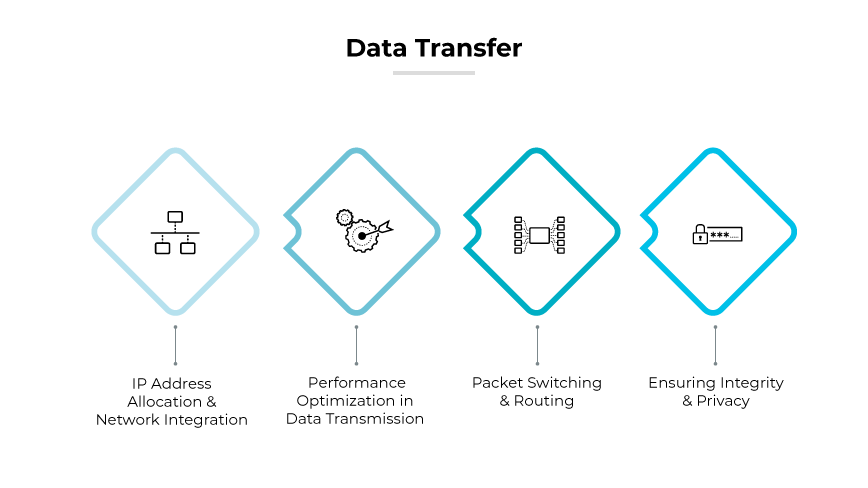
IP Address Allocation and Network Integration
After a secure channel is established, IP address allocation is central to integrating the client into the network. Each VPN client is assigned an IP address from a designated pool, which is crucial for directing packets to their proper destinations. IP address allocation enables the client device to effectively join the corporate network. This allows the client to access resources in alignment with established permissions and policies.
Performance Optimization in Data Transmission
In this phase, the efficiency of the data transfer comes to the forefront. VPN protocols can incorporate mechanisms like compression to improve throughput and reduce latency, optimizing network performance. The choice of tunneling protocol can impact connection speed and reliability. Protocols like point-to-point tunneling (PPTP) offer higher speeds but lower security, and others like OpenVPN provide a better balance of speed and security.
Packet Switching and Routing
The method by which data packets navigate through the VPN is pivotal for maintaining a high-performance connection. Packet switching techniques allow for dynamic packet routing. This accounts for factors like network congestion and changing conditions in real-time. A dynamic approach ensures that the VPN can maintain a stable and efficient connection, even in the face of varying network demands.
Ensuring Integrity and Privacy
Once data packets are prepared for transit, they travel through the secure tunnel, effectively isolated from outside interference. This privacy is not just about concealing data from potential eavesdroppers. It also maintains packet integrity, ensuring that no parts of the communication are altered in transit.
At the tunnel's end, the VPN server processes the incoming packets. It decrypts the data and strips away encapsulation to forward original data to its intended destination within the corporate network.
5. Network Routing and Resource Access
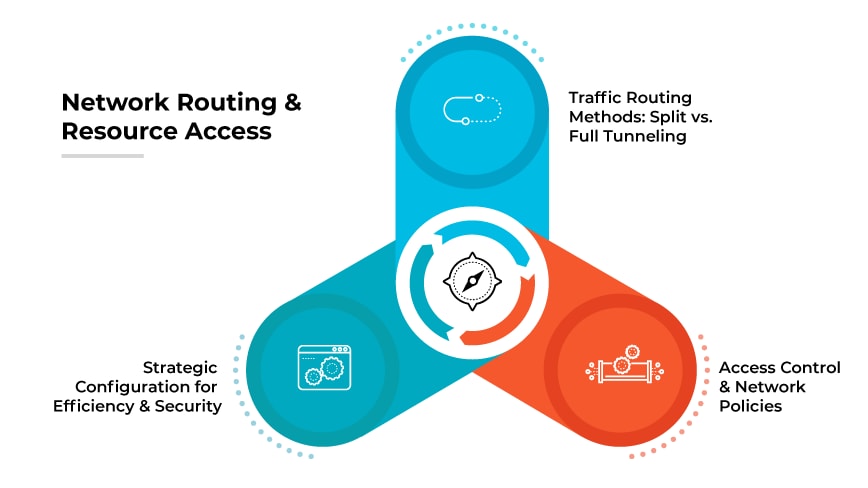
Traffic Routing Methods: Split vs. Full Tunneling
VPN technology offers two main methods for routing client traffic to the corporate network: split tunneling and full tunneling.
Split tunneling allows for direct internet access by the user's device for noncorporate traffic. This conserves bandwidth on the corporate network. However, this can introduce security risks, as traffic does not benefit from corporate firewalls and other security measures.
Full tunneling routes all client traffic through the VPN to the corporate network, regardless of its destination. This ensures all data is subject to corporate security policies but can result in increased bandwidth usage and potential network congestion.
Access Control and Network Policies
Access to network resources via a VPN is regulated through access control lists (ACLs) and network policies. ACLs are a set of rules that define which users or system processes are granted access to objects, and which operations are allowed on given objects. Each entry in an ACL specifies a subject and an operation; for example, it can allow a user to read a file but not to modify it.
Network policies may further dictate terms based on user roles, device compliance status, and other factors. They ensure that only authorized users can access sensitive corporate resources, and define the conditions under which those resources may be accessed. These measures are central to safeguarding the corporate network and preventing unauthorized access to sensitive data.
The strategic configuration of network routing and resource access is critical in balancing operational efficiency and security in a corporate VPN setup. Through appropriate tunneling methods and strict access controls, enterprises can ensure both the productivity and protection of their digital assets.
6. Ongoing Connection Management

Integrity Checks and Data Protection Mechanisms
Ongoing connection management in a VPN ensures continuous protection and stability of the network link. For data integrity, VPN protocols incorporate mechanisms like checksums and sequence numbers.
A checksum is a value derived from the sum of the bytes in a data packet, which is used to detect errors after transmission. If the checksum computed by the receiver matches the sender’s, it confirms that the data has not been tampered with in transit.
Sequence numbers help maintain the correct order of packets. This prevents replay attacks where old messages are resent, potentially disrupting communication or facilitating unauthorized access.
Connection Stability and Control Messages
The VPN connection is kept alive and stable using heartbeats and keepalive messages.
Heartbeats are regular signals sent by one device to another to confirm the connection is active. If a heartbeat is not returned, it signals a potential issue with the connection, prompting corrective measures.
Keepalive messages serve a similar purpose. They are sent at predefined intervals to keep the connection open even when no actual data is being transmitted. This is crucial for VPNs because idle timeouts could otherwise close the connection, interrupting access to the corporate network.
These checks and messages allow for dynamic adjustment to changing network conditions while safeguarding data integrity and confidentiality. They contribute to creating a reliable and secure channel for corporate communications over potentially insecure public Wi-Fi networks.
7. Connection Termination
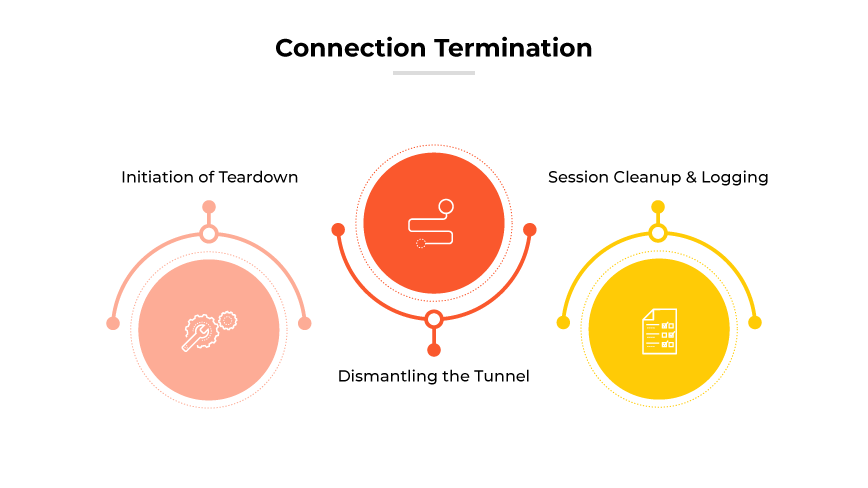
Teardown Process and Secure Closure
The connection termination is a critical phase that ensures the secure closure of the communication session.
The teardown process begins when the user's VPN client signals the server to end the session, or when the server itself initiates the termination due to inactivity or user log-off. This signal starts a series of messages that confirm the closure of the tunnel. VPN software then proceeds to dismantle the tunnel, often using a controlled sequence of steps. Dismantling includes sending a termination packet, which ensures that both ends of the VPN tunnel acknowledge the session end.
Session cleanup is an important post-termination step. The VPN server ensures that any allocated resources, such as IP addresses, are released while temporary data associated with the session are deleted. This maintains the integrity and security of the VPN service for future connections.
Session logging plays a pivotal role in maintaining a record for audit and compliance purposes. Logs can provide details about connection times, data transfer volumes, and user activity. These records are often reviewed for security audits to ensure adherence to corporate policies. Logs are also monitored for anomalous activity that might indicate a breach.
The connection termination process safeguards against unauthorized access and potential data leaks. Session cleanup and logging allow for ongoing security assessments in the corporate VPN environment.
How Does a VPN Work? FAQs
- Pre-connection setup
- Initiation
- Establishing the tunnel
- Data transfer
- Network routing and resource access
- Ongoing connection management
- Connection termination
To use a VPN:
- Install the VPN client software from your provider.
- Enter your login credentials.
- Select a server location for your desired virtual address.
- Connect. Your internet traffic is now encrypted, securing your online activities within a private network.
This is a simplified overview. Exact usage steps vary depending on the VPN.